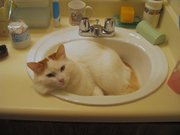 |
 |

CAT BREEDS A-Z Turkish
Van Characteristics The Van is one of the larger cat breeds. The males can reach 20 lb (9 kg) and the females weigh about half of that. They have massive paws and rippling hard muscle structure which allows them to be very strong jumpers. Vans can easily hit the top of a refrigerator from a cold start on the floor. They are slow to mature and this process can take 3-5 years. Also, their fetching skills are quite good and they are quick to learn. Another interesting trait
is their fascination with water (rare among cats). Vans are also
called the "Swimming Cats" since they have been known
to take a dip in Lake Van in their native country. They may have
acquired this trait due to the very hot summers and have extremely
waterproof coats that make bathing them a challenge. Most Vans in
the US are indoor cats and do not have access to large bodies of
water but their love and curiosity of water stays with them. Instead
of swimming they stir their water bowls and invent fishing games
in the toilet. Preservation Vans are sometimes confused with Turkish Angoras, although a side-by-side comparison reveals vastly different characteristics. Angoras are named after Ankara (Angora) and descended separately from the Vans. Angoras also carry the W gene associated with white fur, blue eyes and deafness while Vans do not. Van eye color can be amber, blue or odd (one each, amber and blue) but Vans with two blue eyes are not deaf like Angoras. Origins In 1955 two British women, Laura Lushington and Sonia Halliday, saw Vans in Turkey for the first time and decided to bring them home. They immediately bred true, confirming they are a true natural breed. A quote from Laura Lushington from the Complete Cat Encyclopedia, edited by Grace Pond and published in 1972: "One of the two accepted
breeds in Turkey, the Van Cat is now known in Britain as the Turkish
Cat. Originating in the Lake Van area of southeastern Turkey, these
cats have been domesticated for centuries (in fact for as long as
the famous Saluki Hound); they are much loved and prized by the
Turks for their exceptional character and unique colouring. Apart
from their great capacity for affection and alert intelligence,
their outstanding characteristic is their liking for water, not
normally regarded as a feline attribute. They not only dabble in
water and play with it, but have been known to enter ponds and even
horse-troughs for a swim – they soon became famous as the
'swimming cats.' I was first given a pair of Van kittens in 1955
while traveling in Turkey, and decided to bring them back to England,
although touring by car and mainly camping at the time – the
fact that they survived in good condition showed up the great adaptability
and intelligence of their breed in trying circumstances. Experience
showed that they bred absolutely true. They were not known in Britain
at that time and, because they make such intelligent and charming
pets, I decided to try to establish the breed, and to have it recognized
officially in Britain by the GCCF."
|
Please don't forget to leave your paws in the Purrfect guestbook!!!
Top Of Page | Back | About Us | Home | Choosing A Cat | Behaviour | Care | Health | Breeds | Facts | Humour | Poems Glossary | My Cat Pictures | Books | Links | Bookmark | Contact Us | Terms Of Use | Disclaimer | Privacy Policy
Copyright © 2006 ThePurrfectPaws
All Rights Reserved.
Feline Illustrations by Abida
Fahim
 head
and the tail, and the rest of the cat is white. It is the maximum
expression of the piebald white spotting gene that makes the van
pattern. A chart of the effects of the gene can be seen here. The
spotting gene appears in many different species (like the horse
and ball python). It also shows up in the common house cat, so a
cat that shows this color pattern but is not registered or from
the Van region, is called a "Vanalike".
head
and the tail, and the rest of the cat is white. It is the maximum
expression of the piebald white spotting gene that makes the van
pattern. A chart of the effects of the gene can be seen here. The
spotting gene appears in many different species (like the horse
and ball python). It also shows up in the common house cat, so a
cat that shows this color pattern but is not registered or from
the Van region, is called a "Vanalike". stinct
hair types in their coat, guard hairs, awn hairs and down hairs,
the Turkish Van only has one. This makes their coat feel like cashmere
or rabbit fur, and the coat dries quickly when wet. Lake Van is
a region of temperature extremes and the cats have evolved a coat
that grows thick in the winter with a large ruff and bottlebrush
tail for the harsh winters and then sheds out short in the body
for the warm summers. The full tail is kept year round.
stinct
hair types in their coat, guard hairs, awn hairs and down hairs,
the Turkish Van only has one. This makes their coat feel like cashmere
or rabbit fur, and the coat dries quickly when wet. Lake Van is
a region of temperature extremes and the cats have evolved a coat
that grows thick in the winter with a large ruff and bottlebrush
tail for the harsh winters and then sheds out short in the body
for the warm summers. The full tail is kept year round.